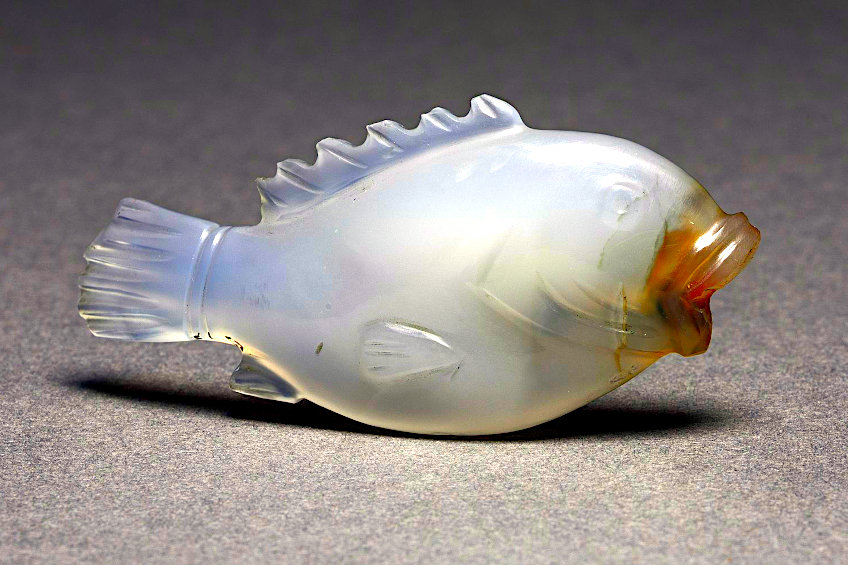Early Christian Art – A Guide to Paleochristian Visual Culture
Christianity is one of the most practiced belief systems around the world. The history of Western art is to a great extent also the history of Christian art, in that a vast percentage of the artworks produced in Europe from late antiquity through the Medieval and Renaissance periods, up to the early Modern period reflected narratives from the Bible and “universal” Christian themes. Despite this, the visual culture of the period of emergent Christianity is not as well known as later Christian art. In this article, we will be exploring the world of Paleochristian and early Byzantine art, including the most famous early Christian paintings and sculptures, as well as a few interesting historical points along the way to help you contextualize the world of early Christian art. Read on for more about the rich history of the earliest Christian artworks!
An Introduction to Early Christian Art
What is early Christian artwork? And when exactly did Christian artwork first appear? In most human societies a large percentage of art is produced for religious purposes. Early Christian art was no different. One of the defining features of early Christianity was its popularity and rapid spread amongst the Roman empire’s poor and enslaved people, most of whom were illiterate. Initially, the use of seemingly innocuous symbols such as the fish allowed Christians to mark places of worship, burial, and safe places to meet. Over time, the depiction of scenes from the life of Jesus, the martyrs, and other tales enabled them to communicate core ideas related to their beliefs.
Early Christian artwork is technically defined as Paleochristian art and describes all forms of art that were inspired by Christian ideas and produced during the early formative phase of Christianity.
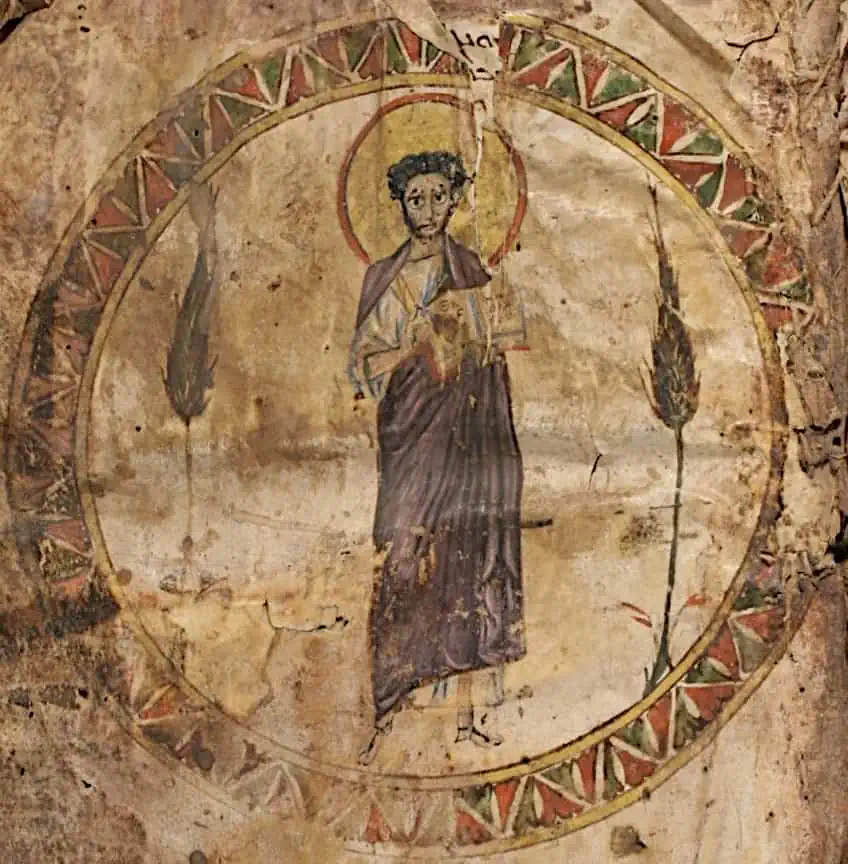
Through an art historical lens, the earliest formal classification of Christian art is widely based on the emergence of art based specifically on Christian themes during late antiquity into the early Byzantine era in Europe where the production of Christian-inspired artworks saw a sharp increase. Although there is no official date for when Christianity itself commenced as a practice, it is clear that the faith influenced and motivated many artists to provide their unique renderings of widely-known biblical subjects, which we will discuss below.
Some of the most notable early Christian artworks were produced by unnamed and undocumented artists whose only traces are left on the walls of the Roman catacombs.
Before we dive into the artwork, it is important to understand some of the most important periods in late Roman history, which impacted the production of early Christian art. These include the pre-Constantinian era, also called the Ante-Nicene period, and the 313 Edict of Milan era, which saw the first council of Nicaea around 325. The Council of Nicaea saw the formalization of Christian doctrine known as the Nicene Creed, and the establishment of the accepted books of the Bible as we know it today. As a result of the council, several early Christian sects such as those that taught Gnostic ideas were declared heretical, along with large numbers of early Christian texts that included some of the most popular accounts that did not conform to the political ideals set out by Emperor Constantine.
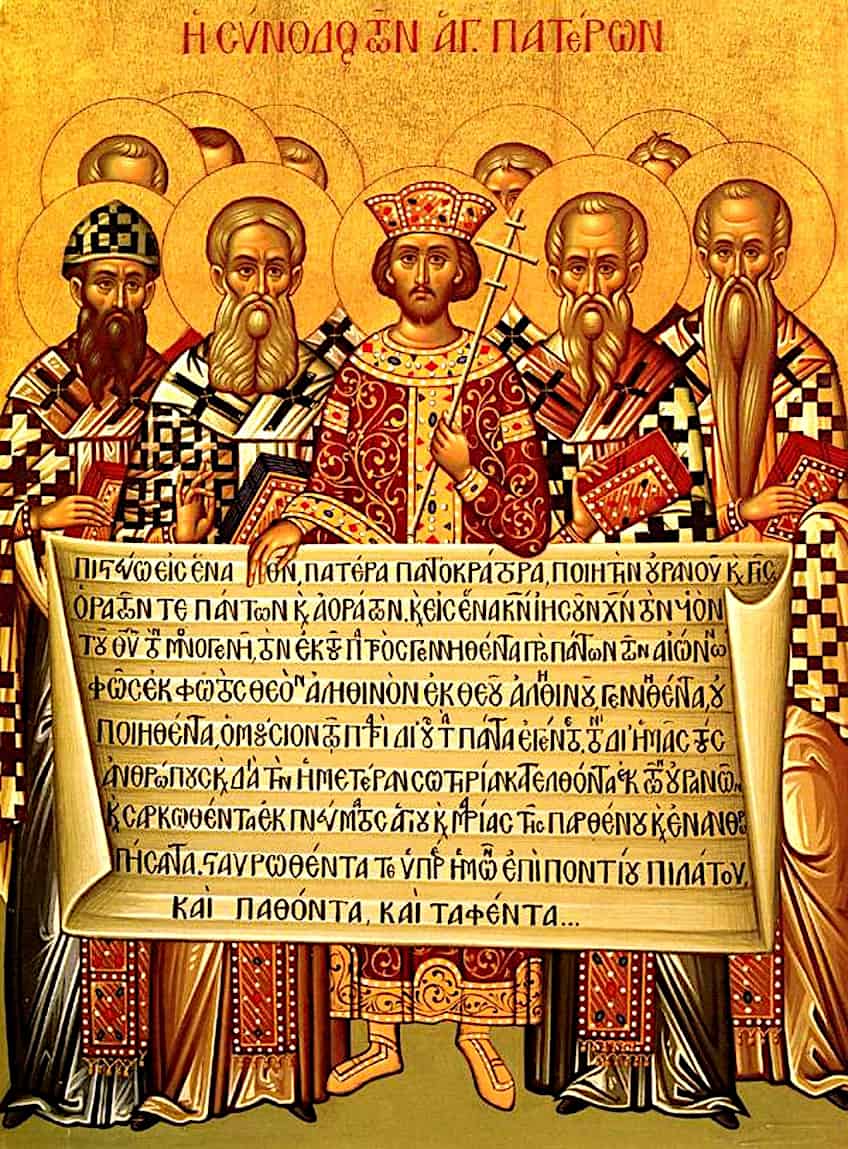
The Council of Nicaea marked the beginning of the end of the earliest Christian period where a vast number sects promoting often conflicting ideas about the nature and purpose of Jesus had co-existed. Christianity as a single set of core beliefs came into being and developed from this meeting. And although sects such as the Gnostics and Manichaeism persevered for many years afterwards, most state authorized Christians now regarded their followers as heretics whose ideas should be suppressed.
The Roman Empire and Christianity
It is important to remember that the Roman Empire before Christianity was driven by polytheism, which involved the worship of multiple deities. Christianity, on the other hand, is a monotheistic religion based on the notion that only one true God exists. When the refusal of Christians to acknowledge the existence of gods other than their own conflicted with the religious practices of the Roman Empire, it caused social and legal schisms that resulted in the persecution and execution of many Christians.
Roman religion was intertwined with the organs of the Roman state. This meant that refusal by Christians to participate in rituals were seen as endangering the welfare of the Roman Empire and it citizens. Since the gods were believed to protect the state, anyone who refused to honor them in the appropriate ways could be prosecuted for treason and various crimes against the empire.
In addition, the extraordinary religious status afforded to martyrs in early Christian thought, often meant that even when Roman authorities were eager and willing to provide accused Christians with the means to escape execution, many refused such aid. Between the 1st and 4th centuries CE, persecution of Christians was not only continuous but also sporadic and resulted in the production of many interesting artworks later on.

Popular Motifs and Icons in Early Christian Art
There are many interesting symbols and motifs in early Christian art, which covers biblical themes related to different pictogram symbols such as the lamb, peacocks, a fish symbol known as the Ichthys, sheep, and pastoral imagery. Early Christian frescoes from the Roman catacombs included such motifs on many panels. The catacombs had long served not only as places of burial. As a belief system greatly concerned with life after death, Christian burials in the catacombs provided ideal opportunities for artworks that represented core tenets of the faith.
Other Christian icons such as the dove embodied an aura of peace and were accompanied by a halo of bright light. The Christian cross, now the most recognizable symbol of the faith, was initially not used by Christians. This was because long after the rise of the faith, most people still associated the deeply humiliating punishment of crucifixion with lowly criminals.

The representation of Jesus in art was also fully developed by the end of the pre-Constantinian era, which included scenes from the New Testament and scenes of Jesus’ Passion. A preference for miracles was also highlighted around this period through representations of Jesus holding a stick or a wand. Popular saints such as Peter and Paul are also featured in religious iconography. The last supper was also a common narrative of early Christian art. Portraits of the historical Christ were also represented by images of “the good shepherd”.
Major Biblical Themes in Early Christian Art
Two main biblical themes in early Christian art include themes of death as well as resurrection. During the 3rd century, the absence of popular scenes such as the nativity and the crucifixion, which describe major events from Christ’s life, was elusive to the period and reflected the state of Christianity at the time. This meant that the 3rd century marked a mysterious period for religion due to the absence of major narratives in religious artwork.
Although themes of Christ’s death and resurrection were not directly represented, they did feature in subliminal ways through other scenes from the Old Testament.
Examples include the story of Jonah and the whale, where Jonah spent three days in the belly of the whale, after which he was vomited onto dry land. In Christian theology, this served as proof of a premonition of the upcoming death and resurrection of Christ and featured often in early Christian art.
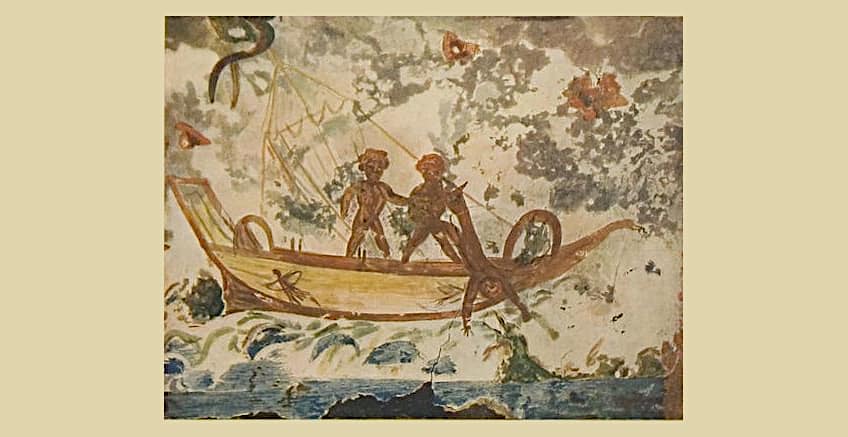
Other important scenes included Daniel imprisoned in the lion’s den, and the three Hebrews in the Fiery furnace among many other scenes that offered glimpses into the Bible’s main character. It is also key to note that these themes were a form of personal salvation to many who were buried in the catacombs through stories about the Israelites fleeing from Pharaoh in contrast to the Christians who faced regular threats from Imperial authorities.
Early Christian Art Forms
One of the most important sites where remnants of early Christian art can be seen includes the Roman Catacombs, which house numerous decorated walls, burial chambers, and frescoes that reflect the influence of Christianity on the culture of people in Europe at the time.
Due to the persecution of Christians, obvious outward displays of adherence to the faith could be dangerous, meaning that Christian visual cultural artifacts produced before the 2nd century are extremely rare.
Below, we will dive into the different art forms that reflected early Christian beliefs and narratives as seen in painting and sculpture.
Early Christian Paintings
Following Emperors Licinius and Constantine’s declaration of the Edict of Milan in 313 CE, which enshrined tolerance for Christianity across the Roman Empire, the demand and production of Christian-inspired artworks increased and reflected the culture which embraced the religion. Below, we will dive into some of the most famous early Christian paintings, which showcase the early developments in European painting through medium and location.

Three Hebrews in the Furnace (3rd Century CE)
| Artist Name | Unknown |
| Date | c. mid-3rd century CE |
| Medium | Fresco |
| Dimensions (cm) | Unavailable |
| Where It Is Housed | Catacomb of Priscilla, Rome, Italy |
For many early Christians, biblical scenes such as the tale of the three Hebrews provided the necessary boost in faith and hope for those who faced persecution from the Roman Empire. Painted onto the walls of catacombs, scenes such as this one were meant for both the dead and the living who remained.

The tale of the three Hebrews describes a scene where the Babylonian king Nebuchadnezzar built a huge monument and ordered all the people to worship it. Only three Jewish men refused, based on the core Hebraic principle prohibiting any worship of graven images. As a result, they were thrown into a fiery pit.
The king was stunned to see a mysterious fourth figure standing with the three men in the fire. He believed that the figure was probably an angel and concluded that God was on the three men’s side. The men were removed from the furnace and the king’s belief and respect for the Hebrew God was established. The simplicity of the fresco of the three Hebrews is powerful since it was also located in a cave with low light and only amplifies the message of the painting and the narrative that it is attached to.
Christ Surrounded by Apostles (c. 4th Century CE)
| Artist Name | Unknown |
| Date | c. 4th century CE |
| Medium | Fresco |
| Dimensions (cm) | Unavailable |
| Where It Is Housed | Catacomb of Domitilla, Rome, Italy |
One of the earliest representations of Christ in the frescoes of the catacombs is the fresco of Christ surrounded by his apostles, dating to the early 4th century, and located in the Catacomb of Domitilla. At first glance, this fresco may be assumed to represent the last supper, but in line with the artistic themes of the century, this painting’s message is instead focused on the theme of Christ being the one true teacher among the apostles.
The fresco illustrates Jesus wearing a classically draped garment while clutching a scroll in his left hand and his right hand demonstrating the ad locutio motion, also identified as the gesture of the orator. His dress and body language emphasize his representation as the ultimate philosopher.
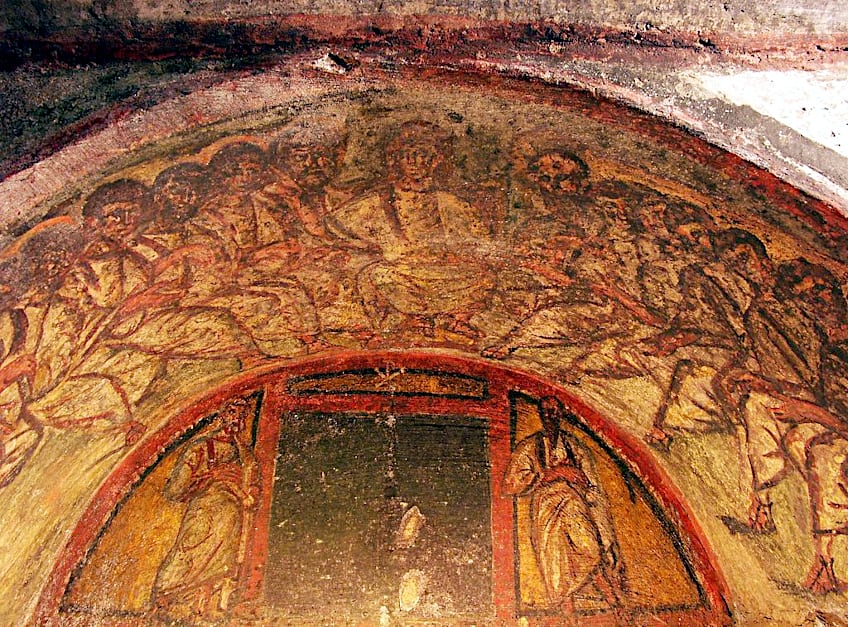
The Virgin and Child in Majesty and the Adoration of the Magi (c. 1100)
| Artist Name | Master of Pedret |
| Date | c. 1100 |
| Medium | Fresco |
| Dimensions (cm) | 322.6 x 592.5 |
| Where It Is Housed | The Metropolitan Museum of Art, New York City, United States |
The Virgin and Child in Majesty and the Adoration of the Magi is an early Medieval Christian artwork that originated from the Church of the Virgin close to Tredòs on the border of Spain and France. The church was located in a remote yet strategic position at the top of the Garonne River. The frescoes housed at the church were inspired by art styles from foreign lands and reflected the art styles of the Byzantine Empire, which were brought there by artists from Italy and Catalonia.
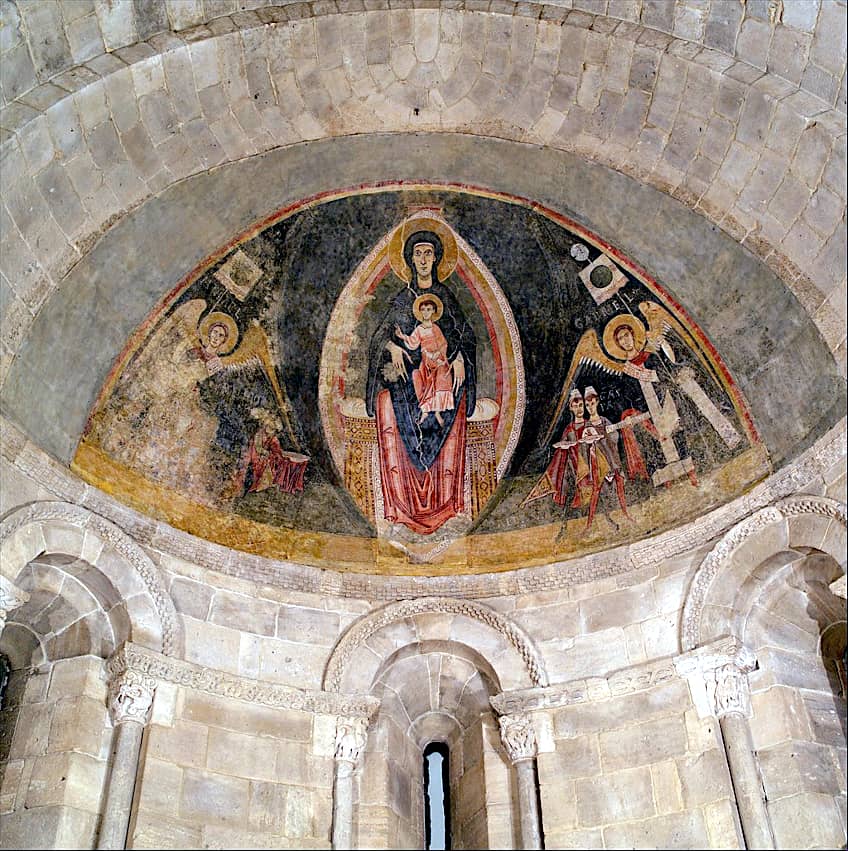
The fresco portrays Mary encapsulated in an almond-shaped vessel with a halo and the baby Jesus on her lap. The mother and son relationship is presented as a potent medium of prayer and demonstrates the readiness of the two who are open to receiving the prayers of the church’s visitors.
Early Christian Sculpture
Sculptures from the early Christian art periods were influenced by both Roman and Greek art, which featured common motifs such as “Christ in Majesty”, which was a motif derived from Imperial Roman portraiture coupled with a depiction of the Greek God Zeus. Below, we will examine a few interesting early Christian sculptures that provide insight into the artistic styles of early Christian artists.

Marble Tomb Relief Fragment: Christ Giving the Law (c. 300 CE)
| Artist Name | Unknown |
| Date | c. late 300 CE |
| Medium | Marble |
| Dimensions (cm) | 49.5 x 134 x 15.2 |
| Where It Is Housed | The Metropolitan Museum of Art, New York City, United States |
This famous marble relief sculpture is one of the most well-known early Christian sculptures that portray the famous biblical narrative of Christ giving the law, as inscribed in the scroll, to St. Peter. The carved fragment derives from a Roman sarcophagus.
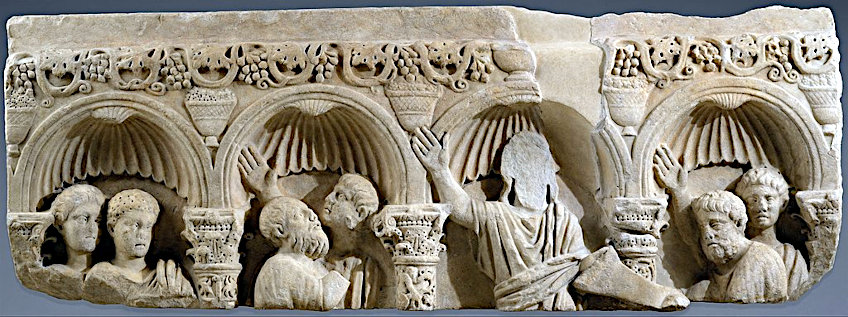
The church’s power grew in influence after it was formally recognized as a religion in 313 CE with the powerful districts encompassing areas such as Alexandria, Antioch, and Constantinople.
Sarcophagus of Junius Bassus (359 CE)
| Artist Name | Unknown |
| Date | 359 CE |
| Medium | Marble |
| Dimensions (cm) | 120 x 140 x 120 |
| Where It Is Housed | Museo Storico del Tesoro della Basilica di San Pietro, Vatican City, Italy |
Following the legalization of Christianity, many people chose to convert to the new religion, which also brought along remnants of Greco-Roman practices. Major changes in Roman culture included funerary practices such as burials, which saw a shift from cremation-led burials to inhumation and the increase in sarcophagi, marble tombs, and many catacombs. Wealthy members of society would have access to more expensive burials such as sarcophagi and ornate tombs and this can be seen in the artwork on the Sarcophagus of Junius Bassus, which demonstrates the sculptural qualities of early Christian art.
Junius Bassus was a high-ranking government official who died around 359 CE. According to scholars, Bassus converted to Christianity not long before his death and this can be seen in the inclusion of images of Christ on his sarcophagus.

The sarcophagus features 10 scenes from the Bible, including Christ with the apostles Peter and Paul in a Traditio Legis joined by a panel showcasing the Sacrifice of Abraham as well as Christ before Pilate and The Arrest of Saint Paul among the other prominent biblical characters. Analysis of the artwork on the relief can be read as a sequence of biblical events that were sculpted with much thought around religious concepts and their multi-tiered meanings.
Archangel Michael Plaque (c. 525 – 550 CE)
| Artist Name | Unknown |
| Date | c. 525 – 550 CE |
| Medium | Ivory |
| Dimensions (cm) | 41.6 x 14.3 x 0.9 |
| Where It Is Housed | The British Museum, London, United Kingdom |
This famous early Byzantine ivory plaque was part of a diptych and illustrates the archangel Michael positioned on top of a flight of six stairs. Above him is an arch displaying acanthus ornamentation with many fluted columns. In the center of the arch is a scallop as well as a wreath with a cross. The inscription on the block above the arch describes the sculpture as “the archangel with no nimbus, holds an orb surmounted by a jeweled cross and on the other hand, a staff with a ball at each end”.
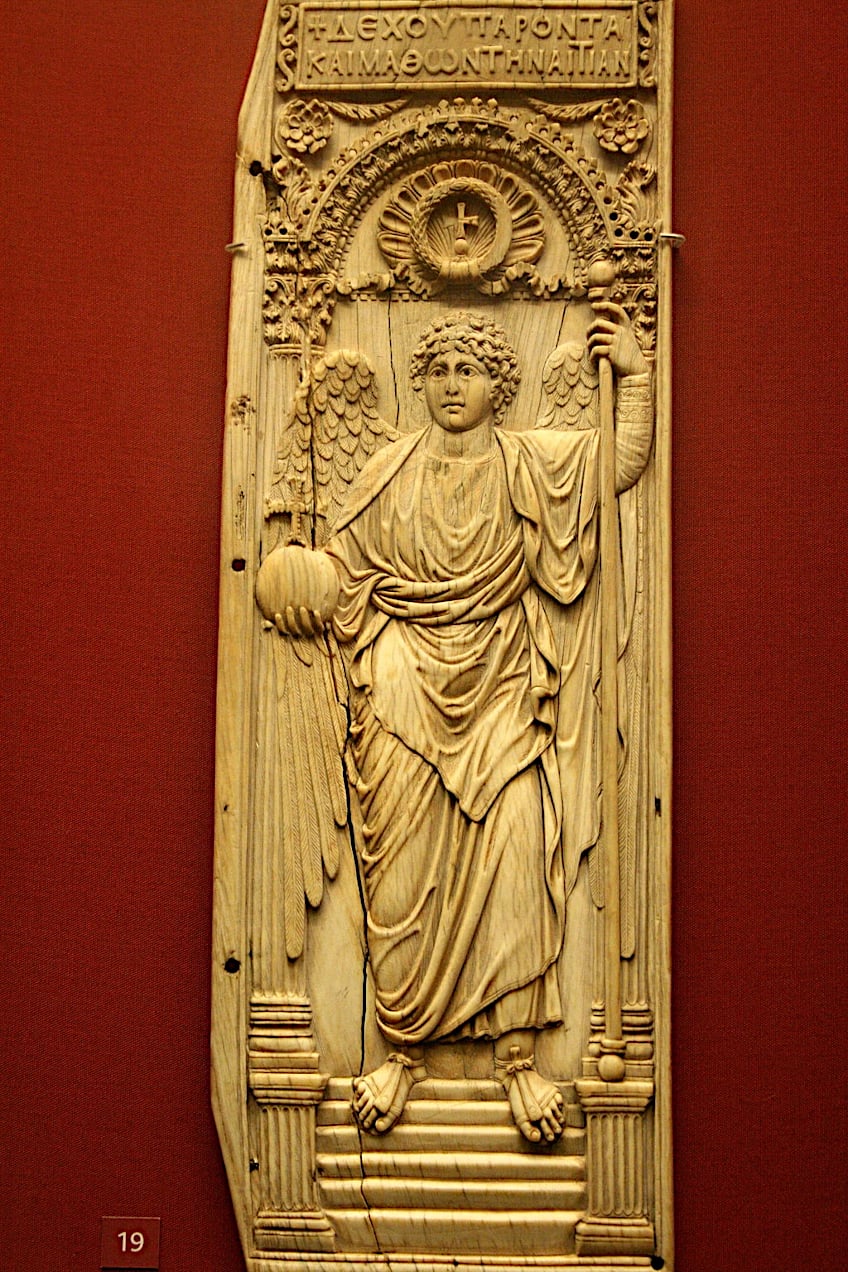
The plaque was originally produced in Constantinople and is a remnant of early Christian sculpture of the early Byzantine era.
Ivory carving was also a popular sculptural medium for small works of Christian-inspired art during the early Byzantine, yet it is unclear as to the extent that it was used before this since many sculptures and large early Christian artworks were destroyed or not produced due to its fine threshold and general reluctance with pagan idols.
Metalwork
Ecclesiastical metalwork was another art form used to express early Christian art and design, and often manifested in the form of silver cups or ornate silverware. Below, we will look at some of the most famous metalworks that were inspired by Christianity.
Flask: Adoration of the Magi (c. 500 CE)
| Artist Name | Unknown |
| Date | c. 500 CE |
| Medium | Silver and silver gilt |
| Dimensions (cm) | 31.5 x 9.9 |
| Where It Is Housed | The Metropolitan Museum of Art, New York City, United States |
This Byzantine-era flask portrays one of the most famous scenes from early Christian art: the adoration of the Magi, which features the archangel Gabriel leading the three wise men to Mary. It is believed that metal flasks such as this were used as pouring vessels in many churches.
Byzantine-era metalworks also feature this scene in many other art forms and it is often associated with pilgrimages.

The Antioch “Chalice” (500 – 550 CE)
| Artist Name | Unknown |
| Date | 500 – 550 CE |
| Medium | Silver |
| Dimensions (cm) | 19.6 x 18 x 15.2 |
| Where It Is Housed | The Metropolitan Museum of Art, New York City, United States |
Long celebrated as the holy relic known as the “Holy Grail” or the cup from which Christ drank during the last supper, The Antioch Chalice, is one of the most famous early Christian sculptures and metalwork pieces in art history. Now known to date from the 6th century, the shape of the “chalice” is closer to the style and design of 6th-century lamps instead of a cup and is now only referred to as a “chalice” due to its earlier identification as the Grail.
Within the grapevine design, one can also spot animals such as a rabbit, an eagle, and a lamb alongside 12 human figures seated in chairs and holding scrolls. Two figures in the ensemble are believed to represent Christ while the rest of the figures represent the apostles or important philosophers of the age.
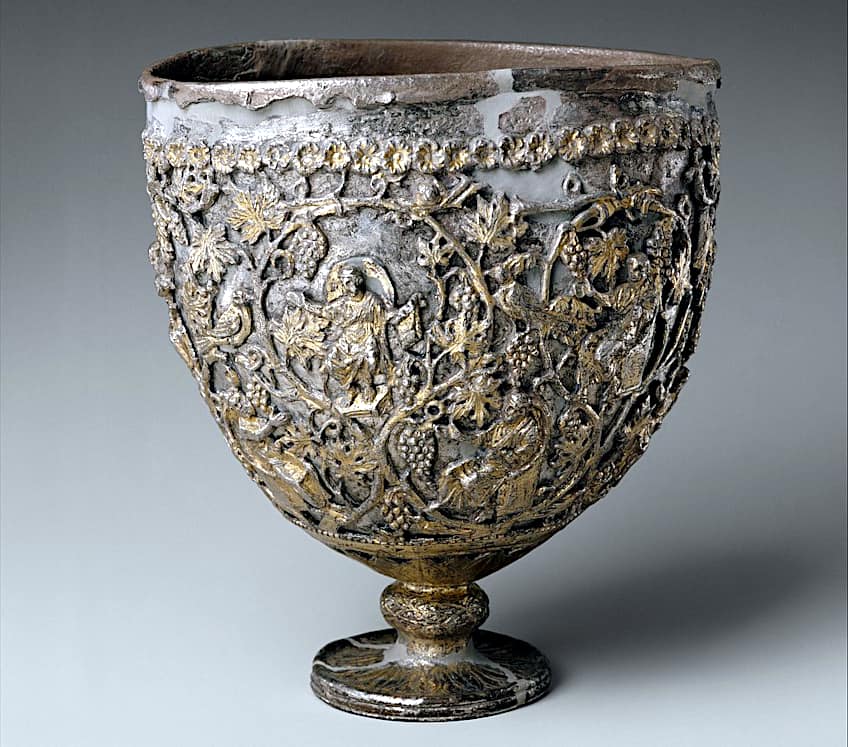
Gold Sandwich Glass
Gold sandwich glass was a specialist medium and approach used in Byzantine, Medieval, and late Roman empire-era artworks. The medium is also referred to as “gold glass” and was regarded as a luxury material. The art of gold sandwich glass involved creating a gold leaf-designed artwork in between layers of glass.
Gold sandwich glass first appeared in the Hellenistic period of Greece and was most popular during the late Roman Empire’s reign around the 3rd and 4th centuries. Early Christians utilized gold glass objects as grave markers in the Catacombs.

Vessels and sculptures that are fully intact are rare finds and many surviving artworks from this medium reflect the work of early Christian artists as well as influences from the different cult groups that emerged with early Christianity and Greco-Roman beliefs. Some examples of gold glass artworks also illustrate portraits and many of the gold sandwich glass objects that survived from these periods showcase the different techniques used. Gold sandwich glass objects often took the form of drinking vessels or bowls.
Illuminated Manuscripts
Illuminated manuscripts can be likened to the modern-day photographic journal applied to different functions yet primarily so in the proto-Renaissance period as theological records and holy books dedicated to the preservation of belief systems and important teachings. The earliest Christian texts found to date were not illustrated, conforming to the primarily text-based belief system of the Judaic religion from which early Christianity largely derived. A vast number of these texts were written in languages like Aramaic and Greek.
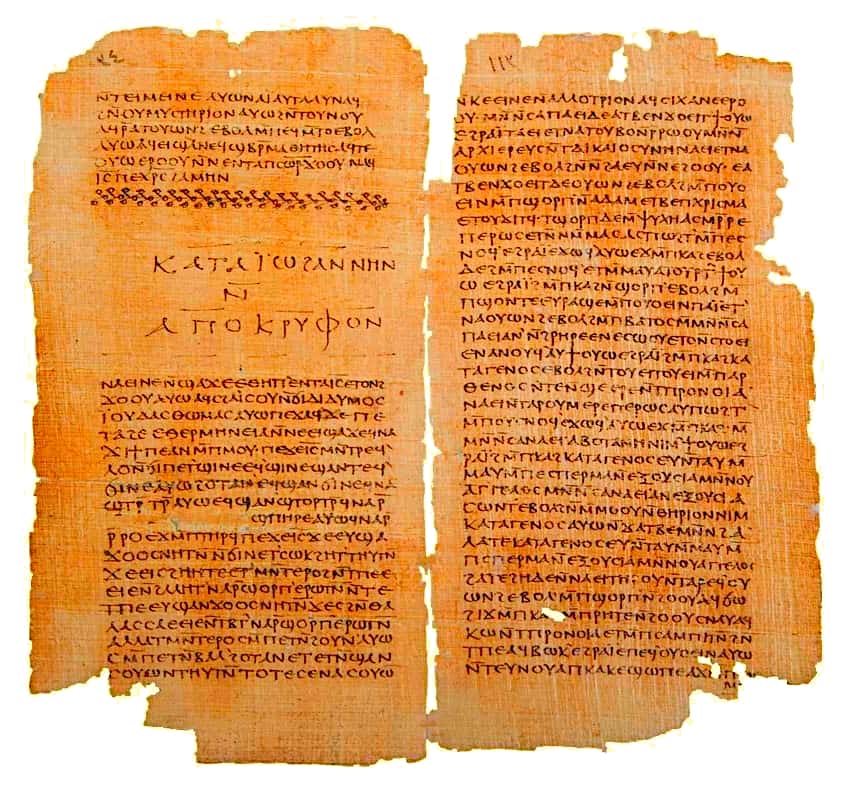
Illuminated manuscripts often contain a variety of texts by one or multiple authors as well as related images and artworks, icons, symbols, and other interesting artistic elements, which provide insight into the relationship between art and religion.
In Western Europe the origins of Christian manuscripts can be traced back to smaller Christian societies that frequented the monasteries in Ireland around the middle of the 5th century. Saint Augustine was sent by Pope Gregory the Great to Britain to preach Christian teachings to the Anglo-Saxons by the late 6th century. The monks who traveled with Augustine carried with them “teaching aids”, which included a silver cross and a painting to resemble the likeness of Jesus. Christianity is an evangelical belief system based on achieving personal salvation in part by converting non-believers. Christian texts carried by the monks were eventually reproduced and copied at various monasteries. In these monasteries, each scriptorium had its own set of writers and artists who helped “illuminate” the teachings, resulting in intriguing Medieval literature and calligraphic art.
Manuscripts become amongst the most popular art forms of the Medieval period, with many important texts such as the Book of Kells and the Lindisfarne Gospel Book, which are great resources for researchers interested in early Christian theology.
Garima Gospels (390 – 660 CE)
| Artist Name | Unknown |
| Date | 390 – 660 CE |
| Medium | Illuminated manuscript |
| Dimensions (cm) | Unavailable |
| Where It Is Housed | Abba Garima Monastery, Aba Gerima, Ethiopia |
The Garima Gospels are an important part of early Christian artwork and an iconic text in Ethiopian heritage. The gospels are considered to be the oldest-known illuminated manuscripts to date and represent Ethiopian Christian thought between the 4th and 6th centuries. The gospel contains many early Christian paintings and is located in the Abba Garima monastery. The credited creator of the book is considered to be a man named Saint Abba Garima, who came from either Syria or Rome to help spread the Christian religion to East Africa.
It is also speculated that Garima was likely a local believer from Constantinople. The Garima manuscripts remain one of the most sacred texts of the ancient East African landscape and its relationship to early Christianity.

The Garima Gospels are one such example of early Christian art that had its roots in the purpose of its creation and its historical legacy. Many artists of illuminated manuscripts with religious or liturgical functions displayed their unique regional styles in these texts, which marked the early stages of the connections between painting and Christianity. The different variations can be seen in manuscripts that originate from Coptic styles, as found in Africa, to Celtic and Byzantine styles. Not all illuminated manuscripts contained colorful or eclectic paintings. A few Celtic manuscripts were more focused on lettering and decorative elements as opposed to pages dedicated to elaborate paintings with complex subjects.
Other interesting, illuminated manuscripts and texts with early Christian artwork include the Harley Golden Gospels, the Echternach Gospels, the Durham Gospel, and the Book of Durrow.
Plaque: Christ in Majesty and the Four Evangelists (c. 1000 – 1100 CE)
| Artist Name | Unknown |
| Date | c. 1000 – 1100 CE |
| Medium | Illuminated manuscript: tempera, ink, metal leaf on parchment; leather, leather binding, and ivory |
| Dimensions (cm) | 36.2 x 26.7 |
| Where It Is Housed | The Metropolitan Museum of Art, New York City, United States |
This plaque created for the cover of manuscript demonstrates the Ottonian artistry of the 12th century and is one of the oldest well-preserved Byzantine-era manuscripts that still holds a plaque. The plaque features a scene with Christ and the four evangelists. It was initially mounted on an Ottonian Gospel book but was moved to a late 15th-century lectionary. It is considered a rare example of Ottonian early Christian manuscript art.
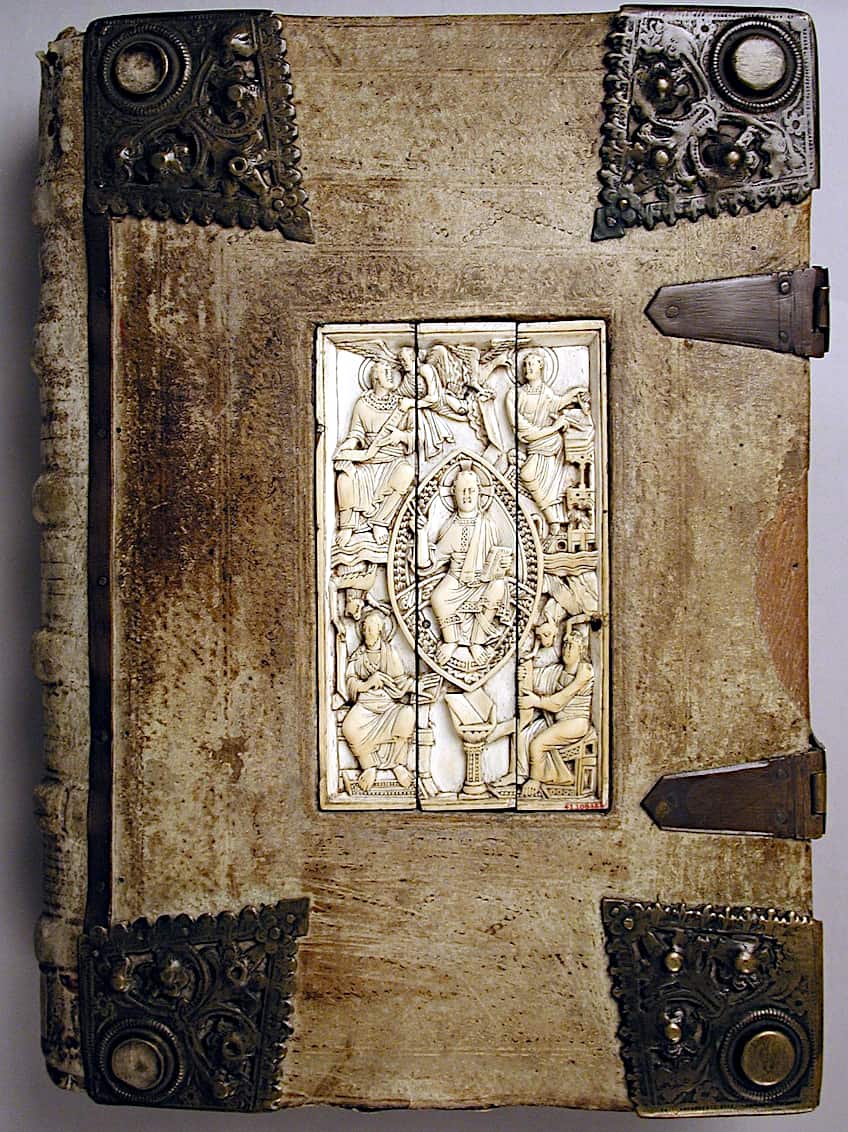
The Ravenna Mosaics
Ravenna is home to some of the best Italian mosaics, which reflect the early Christian interests of the 5th and 6th centuries. Mosaic art dates back to the ancient age of antiquities in Europe and the Mediterranean and often featured classical symbols, historical subjects, and religious iconographies, as seen in the Ravenna mosaics. The city contains around eight UNESCO Ravenna artworks, which are all within walking distance of each other.
The mosaics of Ravenna are great subjects for studying the early Christian art of the late Roman empire and the early Byzantine period.
The Basilica di Sant’Apollinare Nuovo as well as the Basilica di Sant’Apollinare in Classe also contain art from the Christian Byzantine empire that conquered Ravenna in the mid-6th century.
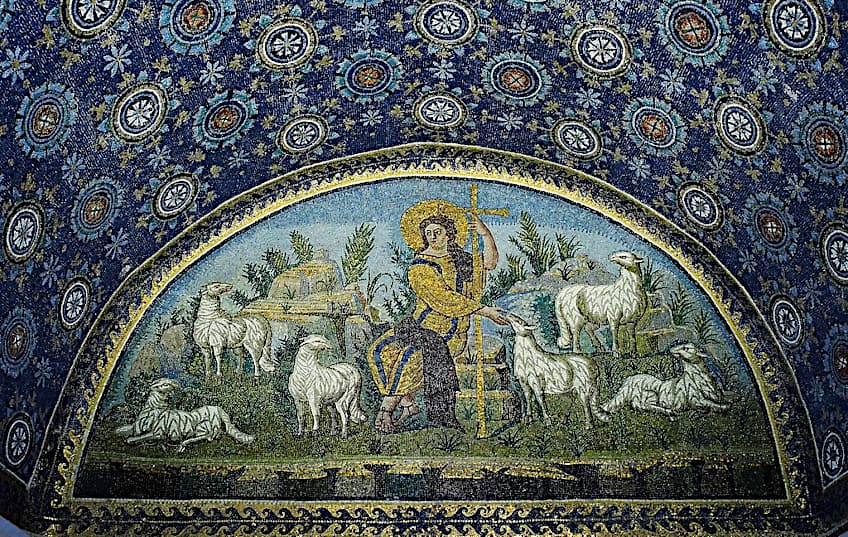
Early Christian art presents insight into the dynamic historical trajectory of Christianity and the many visual manifestations through which artists have for centuries resurrected ancient narratives. We hope that this introduction to early Christian art has shed some light on the origins of Christianity in art, and the connections between religion, art, and the role of politics in the survival of religious artwork.
Frequently Asked Questions
What Is Early Christian Art?
Early Christian art is considered to be any painting, sculpture, drawing, or artifact that was inspired by the Christian religion from as early as the 2nd century until the first quarter of the 6th century CE. Early Christian art encompasses late Roman and early Byzantine-era artwork, spanning multiple centuries and locations across Europe, the Mediterranean, and East Africa.
What Were the Most Popular Motifs in Early Christian Art?
The most popular motifs in early Christian art include motifs inspired by Roman art from the period of antiquities. This included pagan symbols, images of the good shepherd as Jesus Christ, the ichthys symbol, vine designs, the cross, and the peacock.
What Were the Most Famous Art Forms of Early Christian Art?
The most famous art forms of early Christian art included sculpture, fresco, wall painting, metalwork, ivory carving, gold sandwich glass designs, illuminated manuscripts, and mosaic art. These art forms were derived from ancient Graeco-Roman art forms and fused with Christian subject matter following the legalization of Christianity in 313 CE, to form many early Christian artworks.
What Are the Main Themes in Early Christian Artwork?
The main themes covered in early Christian artwork include scenes from the life of Jesus Christ, as well as themes of the resurrection and the crucifixion. Artworks that dealt with themes of the resurrection and the crucifixion were related to early cults and were why many early Christian artworks carry an air of mystery around them, since not much is known about the specific cult or Christian group for which they were made.
Liam Davis is an experienced art historian with demonstrated experience in the industry. After graduating from the Academy of Art History with a bachelor’s degree, Liam worked for many years as a copywriter for various art magazines and online art galleries. He also worked as an art curator for an art gallery in Illinois before working now as editor-in-chief for artfilemagazine.com. Liam’s passion is, aside from sculptures from the Roman and Greek periods, cave paintings, and neolithic art.
Learn more about Liam Davis and about us.
Cite this Article
Liam, Davis, “Early Christian Art – A Guide to Paleochristian Visual Culture.” artfilemagazine – Your Online Art Source. July 17, 2023. URL: https://artfilemagazine.com/early-christian-art/
Davis, L. (2023, 17 July). Early Christian Art – A Guide to Paleochristian Visual Culture. artfilemagazine – Your Online Art Source. https://artfilemagazine.com/early-christian-art/
Davis, Liam. “Early Christian Art – A Guide to Paleochristian Visual Culture.” artfilemagazine – Your Online Art Source, July 17, 2023. https://artfilemagazine.com/early-christian-art/.


